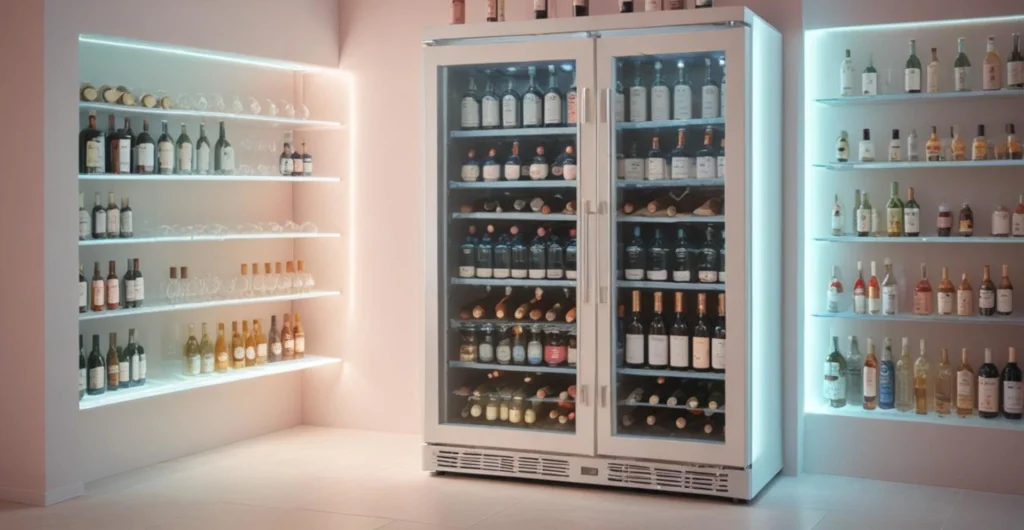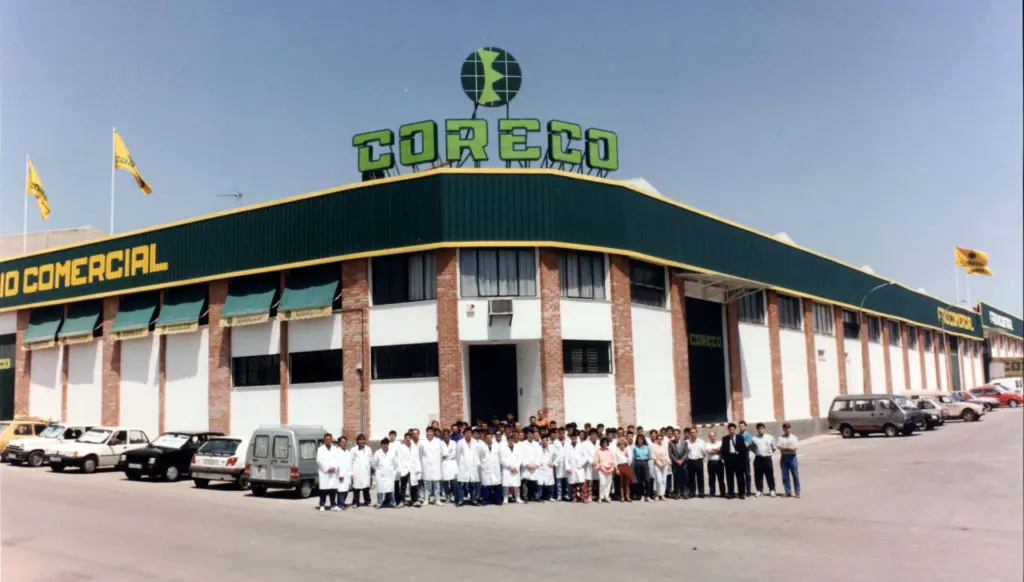Thank you for coming one more day to the blog of Coreco Gourmetwhere we provide answers and analyse practices and technologies for the hotel and catering sector. Today we will focus on how to create an efficient wine cellar in your restaurant using refrigerated wine cellars. Good wine storage is essential to ensure its quality, especially in an environment where wine is a fundamental element of the gastronomic experience. Throughout this article, we will look at how you can optimise your space, choose the right wine cellar and ensure that each bottle is preserved in the best conditions.
Tips on refrigerated wine cellars in restaurants
1. The importance of an efficient restaurant cellar
Wine plays a key role in many restaurants' offerings, and its proper cellaring is essential to provide customers with the best tasting experience. A poorly managed cellar can compromise the quality of the wine, which can result in damaged bottles or the loss of the flavour nuances that customers expect. On the contrary, a well-planned and well-equipped wine cellar with refrigerated wine cellars ensures that the wine is always in optimum condition, improving not only the diner's experience, but also the profitability of the business.
The use of these wine cooler cabinets is essential to maintain controlled temperature and humidity, key factors in wine preservation. They also allow restaurants to optimise the space available to store a wide variety of wines without compromising their quality.
Do you want to improve the conservation of your wines in your restaurant?
to create an efficient wine cellar in your restaurant.
2. Selecting the right space for your winery
The first step in creating an efficient wine cellar in your restaurant is to selecting the right space. Ideally, this space should be away from heat sources, such as kitchens or ovens, and in an area of the restaurant where temperature fluctuations are minimal. Refrigerated wine cellars are extremely useful in this respect, as they allow a wine cellar to be installed even in small spaces or with suboptimal environmental conditions, guaranteeing precise climate control.
If your restaurant does not have a traditional underground cellar, a refrigerated wine cellar can offer a compact and efficient solution for storing your wine selection. In addition, many wine cellars are designed to blend in with the restaurant furniture, making them ideal for limited space.
Council: Consider installing refrigerated wine coolers in visible places in your restaurant, such as at the bar or in a display area, where the bottles are in full view. This not only creates an attractive ambience, but also promotes your wine offer.
3. Choosing the right refrigerated wine cellar for your restaurant
Choose the refrigerated cellar The right wine cellar is one of the most important aspects of ensuring an efficient wine cellar. There are several factors to consider when selecting a wine cellar, including size, storage capacity, the type of wine you will be storing and any additional features you may need. Below, we look at some of the key aspects to consider.
Storage capacity
The capacity of the wine cooler is one of the first factors to evaluate. You should select a wine cooler that fits the volume of wines you regularly handle in your restaurant, as well as the variety of wine types (red, white, sparkling, etc.). Refrigerated wine cellars are available in a variety of sizes, from compact models that can store a few bottles to large units that can hold hundreds of wines.
- Recommendation: If your wine list includes a wide variety of red and white wines, consider the option of a dual zone wine cellar, which will allow you to maintain different temperatures simultaneously, optimising the preservation of each type of wine.
Temperature and humidity control
The precise temperature control is essential for the preservation of wine. Wines require different temperatures depending on their type: red wines generally need to be stored at a temperature of between 12°C and 18°Cwhile whites and sparkling wines require a lower temperature, between 7°C and 12°C. A quality refrigerated wine cellar will allow you to adjust these parameters precisely for each type of wine.
In addition to temperature, the humidity is also crucial. A humidity level between 50% and the 70% is ideal for preventing corks from drying out, which can cause oxygen to enter the bottle and spoil the wine.
- Council: Choose a wine cellar with automatic humidity control to ensure that your wines are kept in the best condition all year round, regardless of variations in the weather.
Additional functionalities
Modern refrigerated wine cellars often offer a number of additional functionalities that can help you manage your wine cellar more efficiently. Some of the most useful include:
- Digital temperature and humidity monitoringThis allows you to adjust the parameters from one screen and receive alerts if there are any variations.
- LED lightingThe energy-saving LED lights do not generate heat, which helps to maintain a stable temperature in the wine cellar while allowing you to display the wine bottles attractively.
- Anti-vibration systemsVibrations can alter the chemical structure of wine during ageing. Top-of-the-range refrigerated cellars are equipped with anti-vibration systems to minimise this risk.
4. Maximising the use of your warehouse space
One of the most common challenges for restaurants is the space optimisationespecially when it comes to storing wine. Modern refrigerated wine cellars are designed to be space efficient, allowing you to store a large number of bottles in a relatively small area. Here are some tips on how to make the most of your storage space:
- Organisation by type of wineOrganise your wine cellar by wine category (red, white, sparkling, etc.) to facilitate selection and quick access to bottles during service. You can also organise your wines by region or vintage, allowing you to highlight the diversity of your cellar.
- Use of adjustable shelves: The refrigerated wine-cellars of Coreco Gourmet are equipped with adjustable shelves that allow you to customise storage according to bottle size. This is especially useful if you store a combination of standard bottles and larger formats, such as magnums.
- Inventory turnoverKeep track of your cellar inventory to ensure that older wines are consumed first, preventing bottles from being stored for too long. An efficient rotation system will help maintain wine freshness and avoid losses.
5. Maintaining the energy efficiency of refrigerated wine cellars
In addition to functionality, it is important that your wine cellar be energy efficient. Chillers are designed to be energy efficient, but their proper use also helps to keep electricity consumption low. Here are a few tips:
- Periodic inspection of doors and sealsMake sure that the cellar doors close tightly to prevent cold air leakage. Damaged seals can increase energy consumption, as the wine cellar has to work harder to maintain the internal temperature.
- Strategic locationPlace the wine cellar in a cool area away from heat sources such as cookers or ovens. This will help to reduce the load on the cooling system and improve energy efficiency.
- Intelligent temperature settingsIt is not necessary to keep all wine cellars at maximum cooling capacity at all times. Adjust the temperature according to the needs of your cellar and service, using monitoring systems to ensure balanced energy consumption.
6. Train staff on the use and maintenance of the cellars.
An efficient warehouse also depends on the staff being trained in the correct use of the refrigerated cellars and in the management of the wine inventory. Make sure that the entire team is familiar with the characteristics of the cellars and knows how to adjust the temperature and humidity as necessary.
In addition, it is essential to establish a regular maintenance plan for these refrigerated cabinets. This includes cleaning the internal surfaces, checking the cooling systems and checking humidity levels. Proper maintenance not only prolongs the life of the equipment, but also ensures that the wines are kept in optimum condition.
7. How to improve the customer experience with an efficient winery
Finally, an efficient wine cellar not only optimises the internal operation of the restaurant, but it can also improving the customer experience. By having a well curated and accessible wine selection, you can offer your diners a superior wine tasting experience, with wines served at the perfect temperature and at their ideal point of maturity.
In addition, a well-managed cellar allows you to have a wider range of wines on offer, which increases your chances of attracting customers interested in speciality or premium wines. The use of refrigerated cellars also ensures that the wines on offer are in their best condition, which can make a big difference in customer perception.
If you want to transform your wine cellar into an essential part of your restaurant's gastronomic experience
Efficient wine cellar? Refrigerated wine cellars for your restaurant
Creating an efficient wine cellar in your restaurant with refrigerated wine cellars not only improves wine preservation, but also optimises service, enhances the customer experience and increases the profitability of your business. With the Coreco Gourmet refrigerated wine cellarscan ensure that every bottle is in perfect condition, ready to be served at the right time.
Thank you for joining us on this journey to create an efficient wine cellar. If you have any further questions or would like more information about our cooling solutions, please do not hesitate to contact us at get in touch with usWe will help you find the perfect refrigerated wine cellar for your restaurant!











